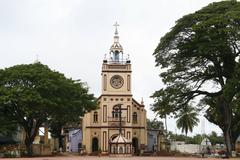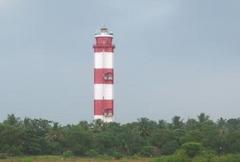
Comprehensive Guide to Visiting Pathadipalam, Ernakulam, India
Date: 23/07/2024
Introduction
Pathadipalam, located in the bustling district of Ernakulam in Kerala, India, is a unique convergence of history, culture, and modernity. This vibrant locality, whose name is derived from the Malayalam words ‘Pathadi’ (meaning ‘path’ or ‘way’) and ‘Palam’ (meaning ‘bridge’), reflects its historical significance as a crucial crossing point (Ernakulam). Ernakulam’s strategic location along the Malabar Coast made it a pivotal center for maritime trade, attracting traders from across the world, including Arabs, Chinese, and Europeans. Today, Pathadipalam stands as a testament to the seamless blend of historical heritage and modern urban development, making it an attractive destination for tourists and locals alike.
With a rich historical tapestry dating back several centuries, Pathadipalam offers a unique experience for every visitor. The region’s history is intertwined with the broader historical narrative of Ernakulam, which saw significant colonial influence under Portuguese, Dutch, and British rule. These influences are still visible in the architectural and cultural landmarks scattered throughout the area. Moreover, Pathadipalam is known for its vibrant cultural festivals, religious diversity, and economic development spurred by modern infrastructure like the Kochi Metro and the presence of premier educational institutions such as the Cochin University of Science and Technology (CUSAT).
This comprehensive guide provides practical information for visitors, including the best times to visit, how to get there, where to stay, and what to explore. Whether you are a history enthusiast, a culture aficionado, or a modern-day traveler, Pathadipalam has something to offer for everyone.
Table of Contents
- Introduction
- History and Significance
- Cultural Significance
- Economic Development
- Modern-Day Significance
- Key Attractions
- Visitor Information
- Travel Tips
- FAQ
- Conclusion
History and Significance
Historical Background
Pathadipalam, located in the bustling district of Ernakulam in Kerala, India, has a rich historical tapestry that dates back several centuries. The region’s history is intertwined with the broader historical narrative of Ernakulam, which has been a significant center of trade and culture since ancient times. Ernakulam’s strategic location along the Malabar Coast made it a pivotal point for maritime trade, attracting traders from across the world, including Arabs, Chinese, and Europeans.
The name “Pathadipalam” itself is derived from the Malayalam words “Pathadi” (meaning “path” or “way”) and “Palam” (meaning “bridge”), indicating its historical role as a crucial crossing point. The area was historically significant as a transit route for traders and travelers moving between the inland regions and the coastal areas.
Colonial Influence
During the colonial era, particularly under Portuguese, Dutch, and British rule, Ernakulam, including Pathadipalam, saw significant infrastructural development. The Portuguese were the first Europeans to establish a stronghold in the region in the early 16th century. They were followed by the Dutch in the 17th century, who left a lasting impact on the architecture and urban planning of the area. The British, who took control in the late 18th century, further developed the region’s infrastructure, including roads and bridges, facilitating better connectivity.
Cultural Significance
Pathadipalam is not just a historical landmark but also a cultural hub. The region is known for its vibrant cultural festivals and traditions that reflect the diverse heritage of Kerala. One of the most significant cultural events is the annual Onam festival, celebrated with great fervor and enthusiasm. Onam, which marks the homecoming of the mythical King Mahabali, is characterized by elaborate feasts, traditional dances like Thiruvathira, and the iconic Vallam Kali (boat races).
The area is also home to several temples, churches, and mosques, showcasing the religious diversity and harmony that Kerala is known for. The St. George Syro-Malabar Catholic Forane Church, located nearby, is a prominent religious site that attracts thousands of devotees and tourists alike.
Economic Development
Pathadipalam has witnessed significant economic development over the years, transforming from a historical transit point to a modern urban locality. The establishment of the Kochi Metro, with a station at Pathadipalam, has been a game-changer for the region. The metro has not only improved connectivity but also spurred economic activities, leading to the growth of commercial establishments, residential complexes, and educational institutions.
The presence of the Cochin University of Science and Technology (CUSAT) in the vicinity has also contributed to the area’s development. CUSAT is one of the premier educational institutions in India, attracting students from across the country and abroad. The university’s research and innovation initiatives have had a positive impact on the local economy, fostering a culture of entrepreneurship and technological advancement.
Modern-Day Significance
Today, Pathadipalam stands as a testament to the seamless blend of history and modernity. The area is a microcosm of Ernakulam’s broader narrative of growth and development. The Kochi Metro station at Pathadipalam is a symbol of this transformation, representing the region’s march towards urbanization while retaining its historical essence.
The region’s strategic location, coupled with its rich historical and cultural heritage, makes it a significant destination for tourists and locals alike. Visitors to Pathadipalam can experience the unique blend of tradition and modernity that defines Ernakulam, from its historical landmarks and cultural festivals to its modern infrastructure and economic vibrancy.
Key Attractions
While Pathadipalam itself is a relatively small area, its proximity to several key attractions in Ernakulam makes it an ideal base for exploring the region. Some of the notable attractions include:
-
Fort Kochi - Known for its colonial architecture, Fort Kochi is a historical neighborhood that offers a glimpse into the region’s colonial past. The Chinese Fishing Nets and St. Francis Church are must-visit sites.
-
Mattancherry Palace - Also known as the Dutch Palace, this historical palace is renowned for its stunning murals depicting scenes from the Ramayana and Mahabharata. It is a UNESCO World Heritage Site and a testament to the region’s rich cultural heritage.
-
Marine Drive - A picturesque promenade along the backwaters of Kochi, Marine Drive is a popular spot for leisurely walks and enjoying the scenic beauty of the region. The Rainbow Bridge and the Chinese Fishing Net Bridge are notable landmarks here.
-
Hill Palace Museum - Located in Tripunithura, the Hill Palace Museum is the largest archaeological museum in Kerala. It was the administrative headquarters of the erstwhile Kochi royal family and houses a vast collection of artifacts, including royal regalia, paintings, and sculptures.
Visitor Information
- Visiting Hours - Pathadipalam is accessible 24/7, but visiting hours for specific attractions like the St. George Syro-Malabar Catholic Forane Church or Hill Palace Museum may vary. It’s advisable to check their official websites for the latest information.
- Tickets - Entry to Pathadipalam is free, but certain attractions may have ticket prices. For instance, the Hill Palace Museum has a nominal entry fee.
- Accessibility - The area is well-connected by the Kochi Metro, with a station at Pathadipalam. It is easily accessible by road and public transport as well.
- Guided Tours - Several local tour operators offer guided tours of Pathadipalam and its surrounding attractions. These tours can provide deeper insights into the historical and cultural significance of the area.
Travel Tips
- Best Time to Visit - The ideal time to visit Pathadipalam is during the winter months (November to February) when the weather is pleasant.
- How to Get There - Pathadipalam is easily accessible by the Kochi Metro. The nearest metro station is Pathadipalam Station. It is also well-connected by road, with frequent bus services and taxis available.
- Nearby Accommodation - There are several hotels and guesthouses in Ernakulam, offering a range of options from budget to luxury accommodations. Staying in Ernakulam provides easy access to Pathadipalam and other nearby attractions.
FAQ
-
What are the visiting hours for Pathadipalam? Pathadipalam itself is accessible 24/7, but specific attractions may have different visiting hours. It’s best to check their official websites for accurate information.
-
Are there guided tours available at Pathadipalam? Yes, several local tour operators offer guided tours of Pathadipalam and its surrounding attractions.
-
What are the ticket prices for Pathadipalam? Entry to Pathadipalam is free, but certain attractions may have ticket prices. For example, the Hill Palace Museum charges a nominal entry fee.
Conclusion
Pathadipalam, with its rich historical background, cultural significance, and modern-day relevance, offers a unique experience for visitors. Its strategic location and proximity to key attractions in Ernakulam make it an ideal destination for those looking to explore the historical and cultural heritage of Kerala. Whether you are a history enthusiast, a culture aficionado, or a modern-day traveler, Pathadipalam has something to offer for everyone.
For more information and to plan your visit, check out the official Kochi Metro website and the CUSAT website.




